The Art of Bluffing in Poker: Tips and Strategies
Bluffing is a fundamental aspect of poker that adds an element of excitement and strategy to the game. It involves representing a stronger hand than what you actually hold in order to deceive your opponents. Mastering the art of bluffing can significantly enhance your chances of winning at poker. In this article, we will explore effective tips and strategies that can help you become a skilled bluffer and take your poker game to the next level.
Understand the Game and Your Opponents:
To bluff successfully, it is crucial to have a deep understanding of the game of poker and the tendencies of your opponents. Pay close attention to their playing styles, betting patterns, and reactions during hands. This information will help you identify potential opportunities to bluff effectively.
Choose the Right Moments to Bluff:
Bluffing should be done selectively and with careful consideration. Look for situations where bluffing is more likely to succeed, such as when there are fewer players in the hand, when you have a tight table image, or when the community cards on the table are unlikely to have improved your opponents' hands. Bluffing randomly or too frequently can quickly lead to predictable play and be easily exploited by observant opponents.
Maintain a Strong Table Image:
Building a strong table image is essential for successful bluffing. Play solid hands and make well-timed aggressive moves when you have a strong hand. This will establish a reputation as a strong player and make your opponents more likely to fold when you bluff. However, be aware that your table image can also be used against you, so it's important to adjust your strategy accordingly.
Use Position to Your Advantage:
Position is a crucial factor in poker, and it can greatly influence the success of your bluffs. Bluffing from late position, such as the dealer button or the cutoff, gives you more information about your opponents' actions and allows you to better assess the strength of their hands. Bluffing from an early position should be approached with caution, as there are more players to act after you, increasing the likelihood of someone having a strong hand.
Mix Up Your Betting Patterns:
Varying your betting patterns is essential to keep your opponents guessing and prevent them from accurately reading your hand strength. Occasionally, make big bets with strong hands and small bets with weaker hands to create confusion. Similarly, bluff with a consistent betting size to maintain consistency in your overall strategy. By doing so, you make it more challenging for your opponents to put you on a specific hand.
Pay Attention to Timing and Body Language:
Timing is crucial when executing a bluff. A well-timed bluff can force your opponents into making hasty decisions or convince them that you genuinely hold a strong hand. Additionally, pay attention to your own body language and avoid any obvious signs of nervousness or excitement, as they can give away the strength or weakness of your hand.
Use the Power of the Continuation Bet:
The continuation bet is a common bluffing technique used after taking the lead with a pre-flop raise. By following up with a bet on the flop, regardless of the strength of your hand, you can often represent a strong hand and force your opponents to fold if they missed the community cards. However, be cautious when using this strategy against observant players who may adapt their play accordingly.
Bluff Against Tight Players:
Tight players tend to fold more often and are less likely to call your bluffs. Identify the tight players at the table and exploit their cautious nature by bluffing more frequently when they are involved in a hand. However, be aware that they may occasionally make strong hands and call your bluff, so exercise discretion.
Practice and Analyze Your Bluffing: Like any skill in poker, bluffing requires practice to refine your instincts and abilities. Take advantage of opportunities to play in low-stakes games or practice with friends to experiment with different bluffing techniques. After each session, analyze your bluffing plays and outcomes to identify areas for improvement. Pay attention to which bluffs were successful, which were detected, and the factors that influenced those outcomes.Stay Mindful of Your Bankroll: Bluffing can be an exhilarating aspect of poker, but it can also be risky. It's important to be mindful of your bankroll and avoid excessive bluffing that can lead to unnecessary losses.
Bluff strategically and choose your bluffing opportunities wisely to maximize your chances of success while minimizing potential risks.
Mastering the art of bluffing in poker requires a combination of skill, observation, and strategic decision-making. By understanding the game, assessing your opponents, choosing the right moments to bluff, and maintaining a strong table image, you can significantly enhance your bluffing abilities. Remember to mix up your betting patterns, use position to your advantage, and pay attention to timing and body language. With practice, analysis, and a mindful approach to your bankroll, you can become a skilled bluffer and add an exciting dimension to your poker game.









